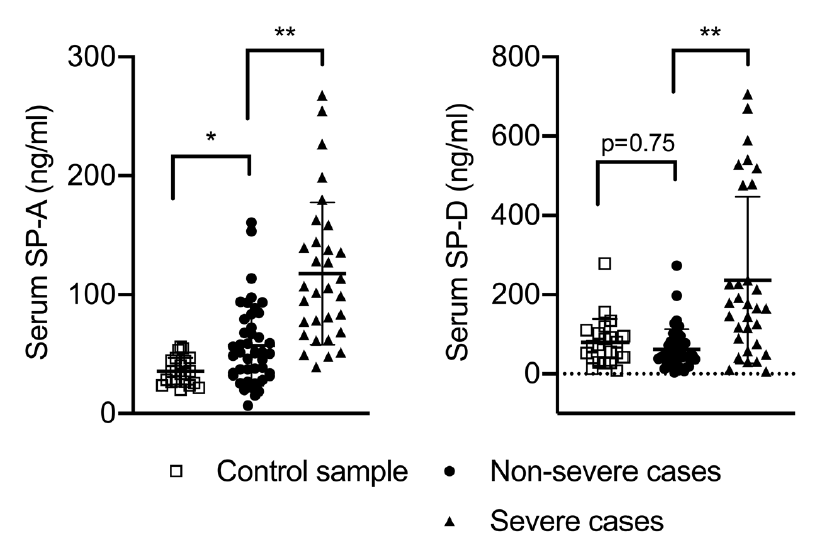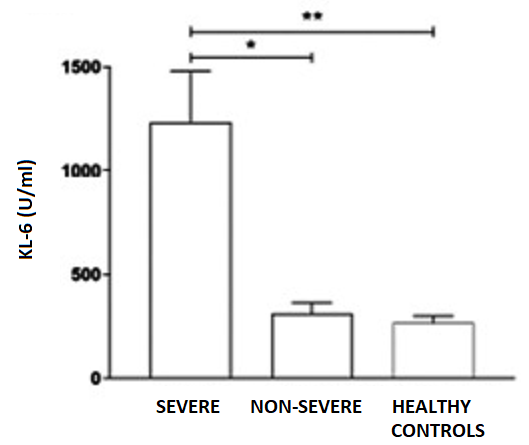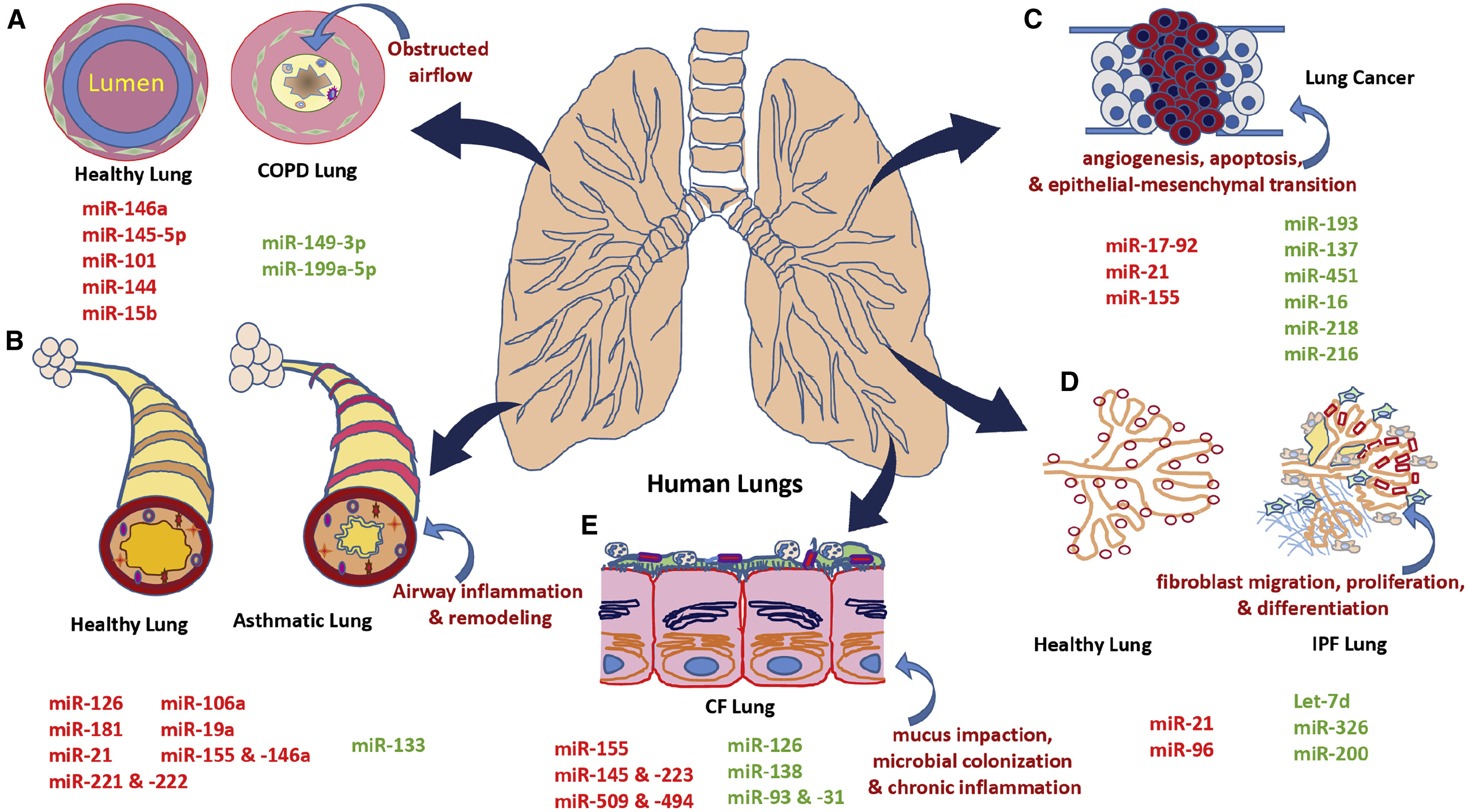
Update 2026: miREIA assay kits have been discontinued as of January 1, 2026.
The microRNA project now continues exclusively on the Two-Tailed RT-qPCR (TT-PCR) platform.
The COVID-19 pandemic has brought new attention to pulmonary diseases and associated biomarkers. Pneumonia and acute respiratory distress syndrome (ARDS) represented the most deadly conditions in COVID-19 patients leaving behind survivors suffering from lung fibrosis or other critical pulmonary complications. Below we will share with you a brief overview of protein & microRNA biomarkers that may be relevant to your pulmonary disease research or COVID-19 research.
Surfactant Protein A (SP-A) & Surfactant Protein D (SP-D)
Surfactant Proteins A (SP-A) and Surfactant Protein D (SP-D) are members of the collectin subgroup of the C-type lectin superfamily and play important roles in innate immunity of the lung.
Human SP-A is expressed primarily in the lung, mostly in alveolar type II cells and also in non-ciliated bronchial epithelial cells. SP-A is considered to be an important host defense component against respiratory allergens and pathogens. SP-A takes part in modulating the function of immune system cells – especially dendritic cells and T-cells.
SP-D is synthesized and secreted by two types of non-ciliated epithelial cells in the peripheral airway, alveolar type II cells and club cells. SP-D binds to the surface glycoconjugates of various microbes and the oligosaccharides associated with the surface of numerous organic antigens and enhances their phagocytosis. Studies have shown that SP-D binds to T cells, thus inhibiting their proliferation. SP-D also binds with inflammatory ligands via protein-protein and protein-carbohydrate interactions that are effective in reducing specific inflammation. In addition, SP-D binds to apoptotic cells and stimulates their phagocytosis by macrophages governed by mechanisms dependent on CD91 calreticulin.
SP-A and SP-D expression levels are associated with a variety of pulmonary disease and have served as prognostic biomarkers for interstitial lung diseases (ILDs) and acute respiratory distress syndrome (ARDS). Recent studies suggest that SP-A and SP-D may have potential as biomarkers of COVID-19 pneumonia severity as well.
Figure 1. Comparison of serum level of SP‐A and SP-D between non-severe COVID-19 cases (closed circle), severe COVID-19 cases (closed triangle), and control subjects (opened square). Serum levels from healthy volunteers and COVID-19 patients were assessed by ELISA. Data are expressed as the mean ± SD. Differences between groups were analyzed by nonrepeated ANOVA with the Student–Newman–Keuls test. *p < 0.05; **p < 0.01.

Source: Saito A, KURONUMA K, Moniwa K, et al. "Serum surfactant protein A and D may be novel biomarkers of COVID-19 pneumonia severity." Research Square; 2020. DOI: 10.21203/rs.3.rs-29567/v1.
SP-A Human ELISA
- Sample Type: Serum, Plasma, Bronchoalveolar lavage, Amniotic fluid
- Quality Controls are human serum based
- Standard is native protein based
SP-D Human ELISA
- Sample Type: Serum, Plasma, Bronchoalveolar lavage, Amniotic fluid
- Quality Controls are human serum based
- Standard is recombinant protein based
- Crossreactivity with bovine, horse, monkey
Club Cell Protein (CC16)
Human Club Cell Protein (CC16) is a member of the secretoglobin family of proteins and is a secreted product of nonciliated bronchiolar Club cells. Club cell protein inhibits phospholipase A2 activity as well as interferon gamma signaling and Th1 vs. Th2 lymphocyte regulation. Club cell protein concentrations have been determined in serum, plasma and bronchoalveolar lavage fluid in numerous studies since 1994.
Data suggests that CC16 functions as an immune-modulating and anti-inflammatory agent. In serum, its increase is associated with age and asbestos, nitrogen chloride and ozone exposure. Higher levels of CC16 were demonstrated in patients with sarcoidosis, pulmonary fibrosis and high PEEP ventilation. Decreased serum CC16 levels are found after pulmonary resection in smokers and in subjects with chronic obstructive pulmonary disease, asthma or silica exposure.
Club Cell Protein (CC16) Human ELISA
- Sample Type: Serum, Plasma, other sample types
- Quality Controls are human serum based
- Standard is recombinant protein based
- Crossreactivity with mouse, monkey
Connective Tissue Growth Factor (CTGF)
Connective tissue growth factor (CTGF or CCN2) is a matricellular protein belonging to the CCN family of extracellular matrix-associated heparin-binding proteins. CTGF is associated with many biological processes such as angiogenesis, chondrogenesis, osteogenesis, and tissue repair or proliferation. High CTGF expression is mainly associated with pathological conditions. CTGF is a common factor in chronic fibrotic and proliferative disorders, characterized by persistent and excessive fibrous tissue which can lead to organ dysfunction and failure, and in cancer, characterized by promotion of tumor growth.
A recent study by Xu, Jincheng et al. concluded that SARS-CoV-2 infection increased ACE2, TGFB1, CTGF and FN1 mRNA that were drivers of lung fibrosis. Clinical trials are currently underway with hospitalized COVID-19 patients to determine if an anti-CTGF monoclonal antibody drug will lead to improved outcomes in both the acute phase of infection and, in the longer term, interstitial lung fibrosis.
Source: Xu, Jincheng et al. “SARS-CoV-2 induces transcriptional signatures in human lung epithelial cells that promote lung fibrosis.” Respiratory research vol. 21,1 182. 14 Jul. 2020, doi:10.1186/s12931-020-01445-6
Connective Tissue Growth Factor (CTGF) Human ELISA
- Sample Type: Serum, Plasma, Urine
- Standard is recombinant protein based
Krebs von den Lungen-6 (KL-6)
Krebs von den Lungen-6 (KL-6), a sialylated carbohydrate antigen, is a high molecular weight glycoprotein that is expressed by type II alveolar epithelial cells and is a mucin which belongs to MUC-1 in cluster 9. It has been confirmed that the serum KL-6 level is significantly higher in subjects with interstitial pneumonia than in healthy volunteers or subjects with other respiratory diseases, and it has been shown by ROC analysis that serum KL-6 is a diagnostically useful indicator. In addition, because serum KL-6 Levels are significantly higher in subjects with active interstitial pneumonia than in subjects with inactive pneumonia, serum KL-6 is considered to be useful for assessing disease activity. Furthermore, it has been noted that this parameter changes according to the pathology of interstitial pneumonia during follow-up.
Figure 2. A recent COVID-19 study by d'Alessandro, Miriana et al. compared KL-6 serum concentrations in severe cases, mild-moderate cases, and healthy controls. KL‐6 levels were only elevated in patients with severe pulmonary involvement, revealing a prognostic value and supporting the potential usefulness of KL‐6 measurement to evaluate COVID‐19 patients' prognosis.

Source: d'Alessandro, Miriana et al. “Serum KL-6 concentrations as a novel biomarker of severe COVID-19.” Journal of medical virology, 10.1002/jmv.26087. 29 May. 2020, doi:10.1002/jmv.26087
Nanopia® KL-6 Immunoturbidimetric Assay
- Sample Type: Serum, Plasma
- AUTOMATED latex agglutination turbidimetric assay
- Applicable to multiple chemistry analyzers
- 2-level control set available
MicroRNA (miRNA) Biomarkers
microRNAs (miRNAs) are small non-coding RNA molecules that regulate gene translation through silencing or degradation of target mRNAs. A typical miRNA is processed from a long primary RNA sequence to a short mature functional transcript around 22 nucleotides in length. A common characteristic of a miRNA is its ability to pleiotropically target potentially hundreds or even thousands of genes, and some function in an organ- or cell-specific manner. miRNAs influence a wide range of major biological processes including differentiation, proliferation, metabolism, apoptosis or inflammation. Deregulation of miRNA levels within cells is associated with various diseases, so they have an immense potential to serve as diagnostic or prognostic biomarkers.
Figure 3. Schematic of MicroRNAs Implicated in Lung Pathophysiology in Different Lung Diseases: miRNAs in red and green indicate whether the miRNA is elevated or reduced in lung-associated diseases, respectively.

Source: Dutta, Rajib Kumar et al. “Aberrant MicroRNAomics in Pulmonary Complications: Implications in Lung Health and Diseases.” Molecular therapy. Nucleic acids vol. 18 (2019): 413-431. doi:10.1016/j.omtn.2019.09.007
miREIA: microRNA Enzyme Immunoassays
miREIA (miRNA Enzyme Immunoassay) is BioVendor's novel, immunoassay-based method of absolute miRNA quantification. The assay can be run on common immunoassay equipment, is compatible with standard clinical workflow, does not require amplification steps and results are obtained in less than three hours including miRNA profiling.
Do you need a miREIA kit that is not in our portfolio yet?
Ask about our On-Request Custom miREIA Production.
BioVendor miRNA Measurement Service
Combining the expertise and experience of 25 years in research, development and manufacturing of immunoassays, BioVendor provides miRNA and protein biomarker analytical services for universities, clinical centres, pharmaceutical and biotechnological industries. An extensive range of analytical solutions enable us to provide you with a perfect service for your research or product development.
BioVendor miRNA Isolation Kits
BioVendor RNA isolation kits are designed for the purification of small and large RNA including miRNA. Validated for use with a variety of samples including whole blood, plasma, serum, cultured cells and tissues, these kits are ideal for use with BioVendor miREIA kits.
ID3EAL miRNA qPCR Assays
ID3EAL™ assays are designed in silico using proprietary 30-parameter thermodynamics based algorithms and are extensively validated using both synthetic miRNAs and RNA from biological samples. Users can select from a growing library of validated human, mouse, rat, and viral miRNA assays.
Two-Tailed miRNA qPCR Assays
Two-Tailed RT-qPCR technology shows exceeding performance compared to other techniques. Instead of using a single binding probe, Two-tailed PCR uses two hemiprobes, which bind to different stretches of the microRNA, that are connected by a folded tether. While each hemiprobe is too short to bind the microRNA, when both hemiprobes are complementary they bind cooperatively. Binding is highly specific, as a mismatch is much more profound in a short hemiprobe. The cDNA formed can then be PCR amplified using two sequence specific primers.
